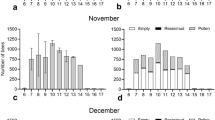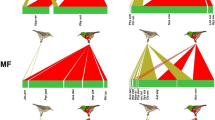Summary
Perhaps the most important factor affecting predator-prey interactions is their encounter probability. Predators must either locate sites where prey are active or attract prey to them, and prey must be able to recognize potential predators and flee before capture. In this study we manipulate and describe three components of the foraging system of predatory, web-weaving spiders, the presence of viscid droplets, silk brightness (achromatic surface reflectance), and visibility of the orb pattern, to determine their effect on insect attraction, recognition, and web avoidance. We found that webs with viscid droplets were more visible to prey at close range, but at greater distances the sparkling droplets lured insects to the web area and hence increased insect capture probability. Although the size of viscid droplets and silk brightness are closely correlated (Table 2, Fig. 3), the relationships among droplet size, spider size, and the visual environments in which webs are found are more complicated (Fig. 2, Tables 2, 3). In environments with predictable light exposure, droplet size and hence silk visibility correlate with spider size, and spiders that forage at night produce relatively more visible silks then spiders that forage during the day (Table 3, Fig. 4). In habitats in which light levels are not predictable, silk surface reflectance and spider size are not closely correlated, suggesting that the complexity of the light environment, as well as the visual and foraging behaviors of insects found there, has played an important role in the evolution of spider-insect interactions.
Similar content being viewed by others
References
Chazdon RL (1988) Sunflecks and their importance to forest understorey plants. Adv Ecol Res 18:2–65
Craig CL (1986) Orb-web visibility: the influence of insect flight behaviour and visual physiology on the evolution of web designs within the Arancoidea. Anim Behav 34:54–68
Craig CL (1988) Insect perception of spider webs in three light environments. Funct Ecol 2:277–282
Craig CL (1989) Alternative foraging modes of five species of tropical orb web weaving spiders. Biotropica 21:257–264
Craig CL (1990) Effects of background pattern on insect perception of webs spun by orb weaving spiders. Anim Behav 38:135–144
Craig CL, Bernard GD (1990) Insect attraction to ultraviolet-reflecting spider webs and web decorations. Ecology 71:616–623
Daniel WW (1978) Applied nonparametric statistics. Houghton Mifflin, Boston
Lubin YD (1973) Web structure and function: the non-adhesive orb-web of Cyrtophora moluccensis (Doleschall) (Araneae, Araneidae). Form Funct 4:337–358
Robinson MH, Robinson B (1970) Prey caught by a sample population of the spider Argiope argentata (Araneae: Araneidae) in Panama: a year's census data. Zool J Linn Soc 49:345–357
SAS (1988) User's guide. Statistics, version 6.03. SAS Institute, Cary
Snedecor GW, Cochran WG (1980) Statistical methods. University Press, Ames
Tillinghast EK, Townley M (1987) Chemistry, physical properties and synthesis of Araneidae orb webs. In: Nentwig W (ed) The ecophysiology of spiders. Springer, Berlin Heidelberg New York, pp 211–228
Tillinghast EK, Kavanagh EJ, Kobjornsen PH (1981) Carbohydrates in the web of Argiope spiders. J Morphol 169:141–148
Turnbull AL (1964) The search for prey by a web-building spider, Achaearanea tepidariorum (C.L. Koch) (Araneae: “Theridiidae”). Can Entomol 97:141–147
Walker J (1987) The amateur scientist: sticky threadlike substances that tend to draw themselves out into bead arrays. Sci Am 257:108–111
Author information
Authors and Affiliations
Additional information
Offprint requests to: C.L. Craig
Rights and permissions
About this article
Cite this article
Craig, C.L., Freeman, C.R. Effects of predator visibility on prey encounter: a case study on aerial web weaving spiders. Behav Ecol Sociobiol 29, 249–254 (1991). https://doi.org/10.1007/BF00163981
Received:
Accepted:
Issue Date:
DOI: https://doi.org/10.1007/BF00163981




